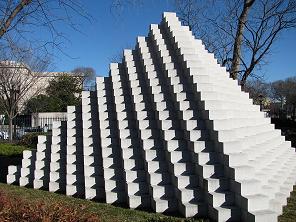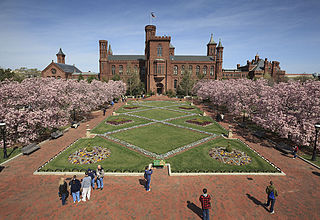
The National Gallery of Art is an art museum in Washington, D.C., United States, located on the National Mall, between 3rd and 9th Streets, at Constitution Avenue NW. Open to the public and free of charge, the museum was privately established in 1937 for the American people by a joint resolution of the United States Congress. Andrew W. Mellon donated a substantial art collection and funds for construction. The core collection includes major works of art donated by Paul Mellon, Ailsa Mellon Bruce, Lessing J. Rosenwald, Samuel Henry Kress, Rush Harrison Kress, Peter Arrell Browne Widener, Joseph E. Widener, and Chester Dale. The Gallery's collection of paintings, drawings, prints, photographs, sculpture, medals, and decorative arts traces the development of Western art from the Middle Ages to the present, including the only painting by Leonardo da Vinci in the Americas and the largest mobile created by Alexander Calder.

The Hirshhorn Museum and Sculpture Garden is an art museum beside the National Mall in Washington, D.C., United States. The museum was initially endowed during the 1960s with the permanent art collection of Joseph H. Hirshhorn. It was designed by architect Gordon Bunshaft and is part of the Smithsonian Institution. It was conceived as the United States' museum of contemporary and modern art and currently focuses its collection-building and exhibition-planning mainly on the post–World War II period, with particular emphasis on art made during the last 50 years.

Alexander Porfyrovych Archipenko was a Ukrainian-American avant-garde artist, sculptor, and graphic artist, active in France and the United States. He was one of the first to apply the principles of Cubism to architecture, analyzing human figure into geometrical forms.

Moondog is a minimalist sculpture created by Tony Smith in 1964. The piece is composed of 15 octahedra and 10 tetrahedra, and while perfectly ordered and symmetrical when seen from certain angles, it carries a strong tilt forward when seen from other angles. This is the third of an edition of three in the series.

Barry Flanagan OBE RA was an Irish-Welsh sculptor. He is best known for his bronze statues of hares and other animals.

The National Gallery of Art Sculpture Garden is the most recent addition to the National Gallery of Art in Washington, D.C. in the United States. It is located in the National Mall between the National Gallery's West Building and the Smithsonian Institution's National Museum of Natural History.
Chakaia Booker is an American sculptor known for creating monumental, abstract works for both the gallery and outdoor public spaces. Booker’s works are contained in more than 40 public collections and have been exhibited across the United States, Europe, Africa, and Asia. Booker was included in the 2000 Whitney Biennial, received a Guggenheim Fellowship in 2005, and an American Academy of Arts and Letters Award for Art in 2001. Booker has lived and worked in New York City’s East Village since the early 1980s and maintains a production studio in Allentown, Pennsylvania.

Four-Sided Pyramid is a conceptual modular "structure", by Sol LeWitt, in the National Gallery of Art Sculpture Garden.

Thinker on a Rock is a bronze sculpture by Barry Flanagan.

Aurora is a public artwork by American artist Mark di Suvero. It is in the collection of the National Gallery of Art and on display at the National Gallery of Art Sculpture Garden in Washington, D.C., United States.

Typewriter Eraser, Scale X is a sculpture of a large-scale typewriter eraser by Claes Oldenburg and Coosje van Bruggen.

House I is a sculpture by Roy Lichtenstein. It has an illusion, which makes it appear inside out, or normally, depending on which way the viewer sees it.

Personnage Gothique, Oiseau-Eclair is a bronze sculpture by Joan Miró.

Gwenfritz is a painted steel abstract stabile, by Alexander Calder. It is located at the National Museum of American History, at 14th Street, and Constitution Avenue, in Washington, D.C.

The Smithsonian Gardens, a division of the Smithsonian Institution, is responsible for the "landscapes, interiorscapes, and horticulture-related collections and exhibits", which serve as an outdoor extension of the Smithsonian's museums and learning spaces in Washington, D.C. Established in 1972 as a groundskeeping and horticulture program, Smithsonian Gardens currently manages 180 acres of gardens on the National Mall, 64,000 square feet of greenhouse production space, and the Archives of American Gardens, a research collection of over 60,000 photographs and archival records covering American landscape history from the 1870s to the present.

Knife Edge Two Piece 1962–65 is an abstract bronze sculpture by Henry Moore. It is one of Moore's earliest sculptures in two pieces, a mode that he started to adopt in 1959. Its form was inspired by the shape of a bone fragment. Moore created the sculpture from an edition of 10 working models in 1962; these working models are now in public collections. Moore created four full-size casts between 1962 and 1965, with one retained by him. The three casts are on public display on College Green in Westminster, London; Queen Elizabeth Park in Vancouver; and the garden at Kykuit, the house of the Rockefeller family in Tarrytown, New York. Moore's own cast is on display at his former studio and estate, 'Hoglands' in Perry Green, Hertfordshire in southern England. A similar work, Mirror Knife Edge 1977, is displayed at the entrance to I. M. Pei's east wing of the National Gallery of Art in Washington, D.C. The Westminster cast was donated by Moore through the Contemporary Art Society to what he believed was the City of London, but its actual ownership was undetermined for many years. The Westminster cast subsequently fell into disrepair, and was restored in 2013 after it became part of the British Parliamentary Art Collection; it was granted a Grade II* listing in January 2016.

Six-Part Seating is a sculpture by Scott Burton, installed at the National Gallery of Art Sculpture Garden in Washington, D.C. The work, conceived in 1985 and fabricated in 1998, consists of six polished red granite seats that can be arranged in a circle or side by side. The seats weigh approximately 1500 pounds each. Visitors are welcome to sit on the seats. The work was given to the National Gallery of Art by the Collectors Committee.
Maggie Michael is an American painter. Born in Milwaukee, Michael has spent much of her career in Washington, D.C. A 1996 graduate of the University of Wisconsin-Milwaukee, from which she received a BFA, with honors, she received her MA from San Francisco State University in 2000 and her MFA from American University in 2002. She has received numerous awards during her career, including a grant from the Joan Mitchell Foundation in 2004, the same year in which she was given a Young Artist Grant by the D.C. Commission on the Arts and Humanities; she has also worked with the Hirshhorn Museum and Sculpture Garden. Michael is married to the sculptor Dan Steinhilber. She has served on the faculty of the Corcoran College of Art and Design.

Wandering Rocks is a 1967 steel sculpture by Tony Smith, made in an edition of five plus one artist's proof. The Minimalist work comprises five different polyhedral elements painted black.













